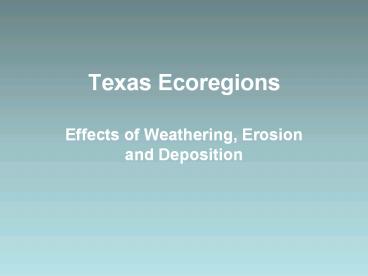Texas Ecoregions - PowerPoint PPT Presentation
Title:
Texas Ecoregions
Description:
Texas Ecoregions Effects of Weathering, Erosion and Deposition Factors Affecting Our Ecoregions Weathering chemical and physical break down of rocks into sediment ... – PowerPoint PPT presentation
Number of Views:190
Avg rating:3.0/5.0
Title: Texas Ecoregions
1
Texas Ecoregions
- Effects of Weathering, Erosion and Deposition
2
Factors Affecting Our Ecoregions
- Weathering chemical and physical break down of
rocks into sediment - Erosion the movement of sediment from one place
to another - Deposition the placement of sediment after
being carried from place of origin
3
CHEMICAL WEATHERING
- THE PROCESS THAT BREAKS DOWN ROCKS B Y CHEMICAL
CHANGES OR REACTIONS.
4
Piney Woods
- This ecoregion is found in Southeast Texas.
- It is the wettest region of the state. This
allows for a high rate of decomposition to occur
resulting in healthy, nutrient-rich soils. - The topography is gently rolling to near flat
through out the region. - Pine trees, woody vines, and hardwood trees
dominate the vegetation. - It is a fire climax system. Fire is necessary in
order for pines to maintain dominance in the
area. - Unless an area has been clear-cut of vegetation
for construction, the amount of trees and plants
can prevent erosion.
5
Gulf Coastal Plain
- Soil in the region is primarily sand-based.
- If there isnt enough vegetation to keep the soil
in place, rainfall received can cause severe
erosion. - Catastrophic events such as hurricanes can
increase wave erosion and deposition.
6
Blackland Prairie Post Oak Savannah
- These areas have nutrient-rich soils and receive
good amounts of rainfall through the year. - If the land is clear-cut of natural vegetation
for construction, nutrients can easily be eroded. - If the land is used for farming and it is not
managed well, nutrients will be quickly used up.
7
Edwards Plateau
- This region is located between dry western plains
and moist prairies and woods. - Unfortunately, erosion has left most of the
region with very shallow soils (less than 10
inches) lined with limestone rock layers. - High amounts of rain in a short amount of time
can cause flash flooding.
8
Rolling Plains
- This region is part of the Great Plains of the
central United States. - Soils in this area are most fertile and sought
after for crop production. - Periods of drought and then sudden increase in
rainfall causes large amounts of erosion and
deplete the soil of nutrients.
9
Western and Eastern Cross Timbers
- This is a small, thin region running North to
South on either side of the prairies and plains. - The soil is not as prone to flooding because it
allows water to infiltrate very easily. - The region is described as rough, hilly terrain.
10
High Plains
- Texas Panhandle
- Largest and most completely flat areas of it size
in the world! - The region extends to the Palo Duro Canyon-the
nations 2nd largest canyon. - Palo Duro Canyon was formed by water erosion from
the Prairie Dog Town Fork of the Red River. - The water deepens the canyon by moving sediment
downstream. - Wind and water erosion gradually widen the
canyon.
11
South Texas Plains
- The area is known as Brush Country due to the
shorter trees and many shrubs. - Overgrazing of the land has allowed nutrient-rich
topsoil to erode way. - Rocky, dry soil cannot support grasses, trees can
thrive because of their deeper root system.
12
Trans-Pecos
- Rain does not fall evenly over the area.
- Desert portion of Texas.
- The weathered bedrock in this area has high
amounts of calcium. - As a result of erosion and deposition in the
area, the soil has high amounts of calcium called
caliche.
13
Mountain Forest / West Texas
- Home of the tallest mountain in Texas, Guadalupe
Peak. Elevation is 8,749 feet. - Pines and Oaks dominate the tree species.
- Soils are shallow and rocky. Weathering
continues to play a role in developing soil and
will for thousands of years to come. - Soils in the canyon bottoms and valleys are
deeper as a result of deposition.































